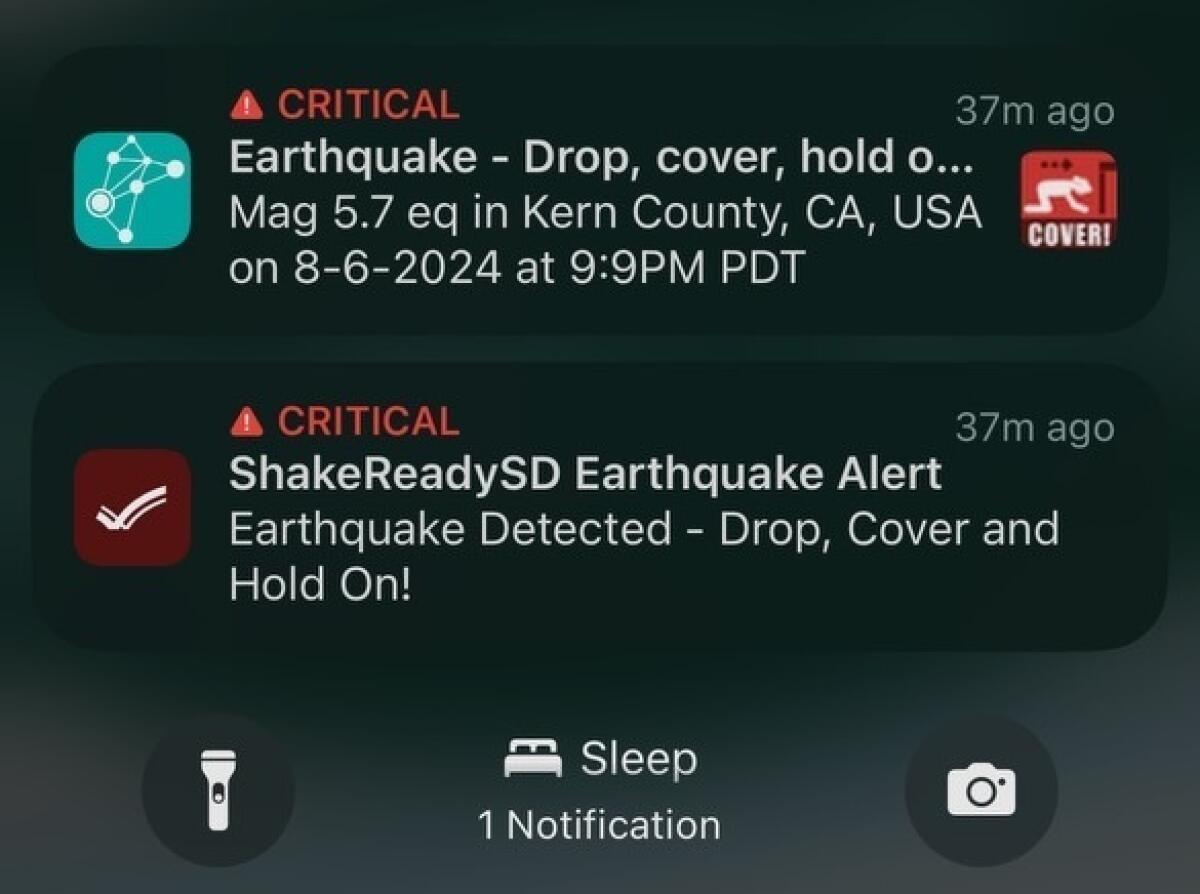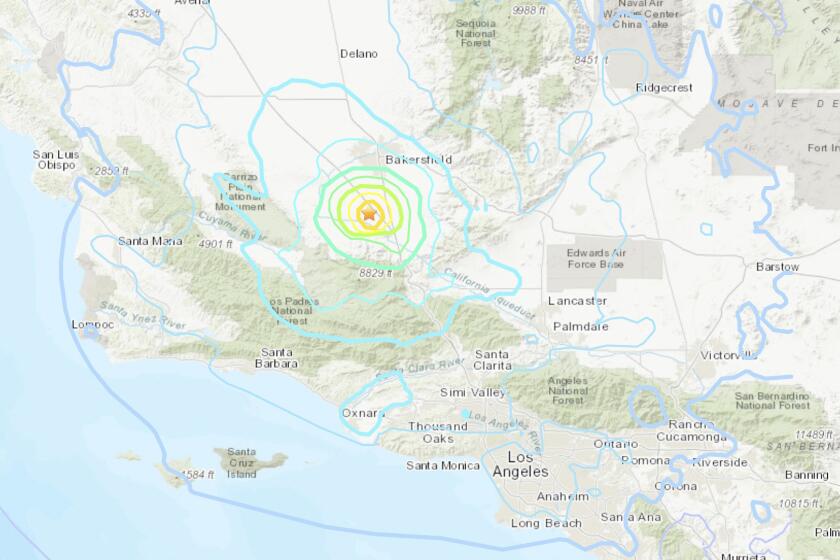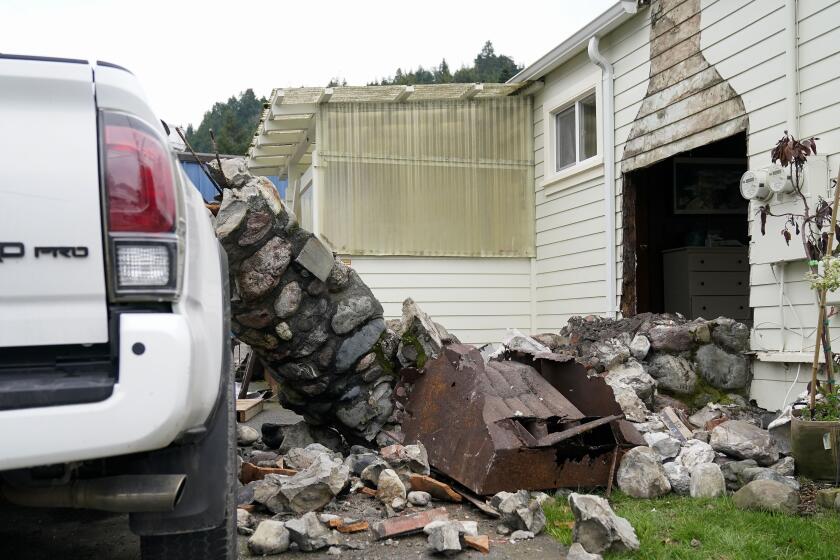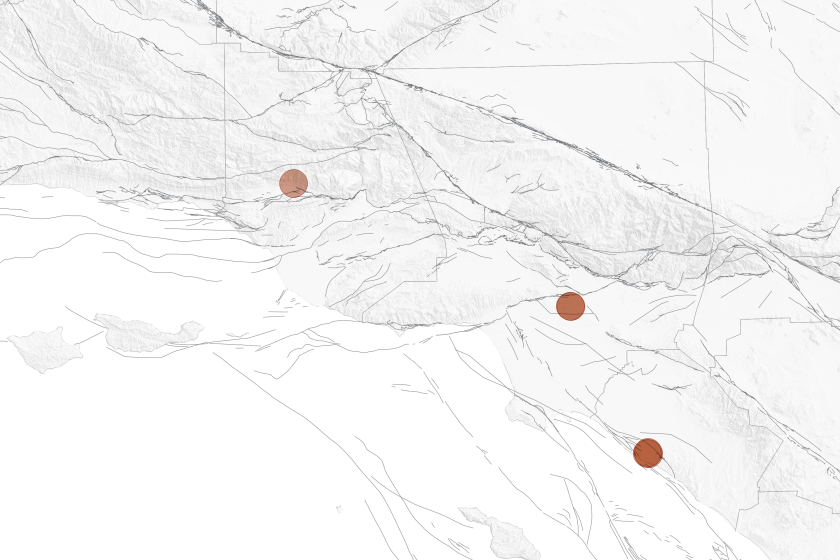California’s earthquake revolution: Early-warning systems make strides, issuing more than 5 million alerts

- Share via
Most Californians know that sinking feeling.
The ground shakes, jolting you to attention. For a split second, your mind considers the possibilities: A truck driving by? Someone dropping a heavy object on the ground?
The truth, though, quickly becomes obvious: EARTHQUAKE!
For centuries, this is how people living in quake country have experienced seismic movement. But over the last few years, technological innovation has created another option: an alarm on your smartphone that gives you a precious few seconds to prepare for the shaking.
California began rolling out free earthquake early-warning apps about five years ago. In 2024, after various improvements, a string of moderate earthquakes and wider use, the network is finally coming into its own.
On Tuesday, more than 5.4 million early-warning alerts went out for the magnitude 5.2 quake that struck Kern County about 18 miles southwest of Bakersfield and 14 miles northwest of the unincorporated community of Grapevine.
“The heartbeat definitely speeds up, and the adrenaline starts pumping pretty much no matter what,” Jennifer Lazo, chief of the innovation and technology division at Los Angeles’ Emergency Management Department, said of receiving the alerts. “But understanding what the noise means, understanding how to quickly look at the message and then quickly take action, I think, is what is key.”
Lazo got the alert on her phone Tuesday night as she began to stand up in the lobby of the Hollywood Pantages Theatre during a show intermission with her mother. She told her mom to sit back down until they could be sure the quake wasn’t significant.
She and her mother didn’t feel much, but realized when they returned to their seats that many sitting in the audience had experienced more shaking.
The magnitude 5.2 earthquake near Bakersfield was felt over a wide area of Southern California. Experts say there are several reason for this, including its size, time of night and the so-called ‘basin effect.’
It was the third time in the last year that many Southern Californians reported getting the ShakeAlert warnings. Many marvel at the technology’s ability to alert them before they feel shaking, as it did July 29 with a Mojave Desert quake, which was sizable enough to feel a little scary but not to cause significant damage.
“It’s cool that we have a series of these ... ‘big-enough’ earthquakes so that we can exercise the system” and give “people a chance to get comfortable with earthquake early warning,” said Robert de Groot, an operations team leader for the U.S. Geological Survey’s ShakeAlert system, which generates the alerts that are distributed to various apps. “That’s really important.”
Scientists want people to get accustomed to the alerts, which they hope will become part of life in California and other earthquake-prone areas of the West Coast.
People reported getting a few seconds of warning Tuesday before they felt shaking in places including Anaheim, Long Beach, Pasadena, Redondo Beach, the San Fernando Valley, the San Gabriel Valley, Ventura and West Los Angeles.

Some even reported a 30- to 45-second heads-up before the shaking. They may have been feeling the first aftershock — a magnitude 4.5 that occurred less than a minute after the magnitude 5.2 quake.
In West L.A., De Groot said his wife first saw the alert on her phone and said, “What is this Kern County thing?” He said the initial warning estimated that weak shaking was expected at their home, and perhaps 15 seconds later, they felt it — a shaking he described as a “very gentle back-and-forth” for about four seconds.
Tuesday’s magnitude 5.2 earthquake was the biggest to strike Southern California in three years. Other recent quakes where many reported feeling shaking include July’s magnitude 4.9 temblor centered in the Mojave Desert and last year’s magnitude 5.1 earthquake near Ojai in Ventura County, which infamously struck on the same day a major storm from the weakened Hurricane Hilary loomed over the area.
Within seconds of Tuesday night’s quake, the earthquake early-warning system calculated it as a magnitude 6.0, and moments later downgraded it to magnitude 5.7. The USGS website said the quake was magnitude 5.3 in its initial posting, but later downgraded that to 5.2.
The magnitude 5.2 earthquake near Bakersfield was felt over a wide area of Southern California. Experts say there are several reason for this, including its size, time of night and the so-called ‘basin effect.’
There were, of course, people who got alerts but didn’t feel shaking, while others close to the epicenter — within 20 miles of the quake’s origin — felt shaking before getting the alert.
But that’s expected: It’s a trade-off made in the interest of getting alerts out to as many people as possible before they feel an earthquake.
The system works on a simple principle: Shaking from a quake travels at the speed of sound through rock — slower than the speed of today’s communications systems. For example, it would take more than a minute for a magnitude 7.8 earthquake that starts at the Salton Sea, along the state’s longest fault, the San Andreas, to be felt 150 miles away in Los Angeles.
Many people, however, aren’t getting the alerts because their phones don’t have an earthquake early-warning app installed. While Google’s Android operating system comes with a built-in app, Apple’s iOS system for iPhones does not.
More than 517,000 alerts were sent to MyShake users, according to the governor’s office, and De Groot said Google delivered more than 4.9 million alerts to Android users.

How to get early quake alerts
Those who have iPhones can get earthquake early warnings by downloading the free MyShake app, developed by UC Berkeley and provided in partnership with the California Governor’s Office of Emergency Services, which alerts users in California, Oregon and Washington. San Diego County also offers the free SD Emergency app, which includes the ShakeReadySD earthquake early-warning tool.
People who don’t have smartphones or haven’t installed early-warning apps can still get quake alerts on their cellphones — but only for those in which a higher magnitude or higher level of shaking is projected at their location. Those alerts are sent through the Wireless Emergency Alert system, similar to Amber Alerts.
Android phones and those with the MyShake or ShakeReadySD apps installed have the lowest threshold for earthquake early warnings: They’re set to trigger alerts if a quake is estimated at magnitude 4.5 or higher and the intensity of shaking at the phone’s location is expected to be “weak” — defined as Level 3 on the Modified Mercalli Intensity Scale.
People who don’t have Android phones or the apps can still get early warnings automatically through the Wireless Emergency Alert system. Its thresholds are a bit more conservative, however: Alerts are triggered to cellphones only if an earthquake’s magnitude is expected to be 5 or higher and the shaking intensity is expected to be “light,” defined as Level 4 on the Mercalli scale.
An unknown number of phones Tuesday night received Wireless Emergency Alerts.
People may remember downloading an earthquake early-warning app released by the city of Los Angeles on New Year’s Eve in 2018 — ShakeAlertLA — but that app was retired at the end of 2020.
Scientists urge California residents to download the early-warning apps, and say it’s not a bad idea to have more than one way of getting alerts on your phone. MyShake is available for both Apple’s iOS and Android.
“It’s worth setting things up. It’s worth getting this technology and using it,” De Groot said. “It works ... it gives us a chance to get comfortable with living” with earthquake early warnings.
An upgrade to California’s earthquake early-warning system using GPS data will allow more timely alerts about shaking and better estimate the magnitude of a megaquake.
Other nations — including Japan, Mexico, Taiwan and Turkey — have operational early-warning systems. They’re a part of life in Japan: Schoolchildren are trained to drop, cover and hold on when they hear the alerts; TV shows are interrupted by a familiar chime with an announcer providing details of the expected shaking; and cellphones automatically broadcast audible alerts.
On Thursday morning, a magnitude-7.1 earthquake was reported off the eastern coast of southern Japan’s main island, Kyushu, briefly sparking concerns of a potential tsunami as officials surveyed the region for damage.
No serious damage was reported, according to area news media, and no tsunamis were expected in California. That earthquake’s epicenter was about 550 miles southwest of Tokyo and about 14 miles southeast of Miyazaki.
Taiwan’s successful early-warning system generated significant attention in March, with many marveling at television journalists who alerted viewers about the strongest shaking from a magnitude 7.4 earthquake before it arrived in their studio, and continued broadcasting warnings even as they strained to remain standing and ceiling lights clashed together.
Initial calls for California’s earthquake early-warning system began more than a decade ago. Officials say it’s now clear that years of investment, made possible in part by the support of elected officials in Washington and Sacramento, is finally bearing fruit.
“Our investments in cutting-edge, innovative technologies are paying off. Efforts like these have allowed us to gain vital seconds between when alerts arrive on Californians’ mobile phones and when the ground starts shaking,” Gov. Gavin Newsom, who announced the MyShake app release in 2019, said in a statement Wednesday.
“Californians, I encourage you to download the app,” he added. “It can save lives!”
Having half a dozen earthquakes with a magnitude 2.5 or greater strike in a single week is not a common occurrence in Southern California.
It can be a little alarming to get your first alert, but the system can help train Californians to prepare for bigger earthquakes.
Seeing the alerts work in real life and not just as a theoretical exercise has been exciting, said Lazo, of L.A.’s Emergency Management Department.
“It shows a lot of hard science at work that’s actually going to have an impact on the public and hopefully make people safer,” she said. “And that is a great thing to see. It’s such a new frontier for us in earthquake response.”
Times staff writers Luke Money, Joseph Serna and Ruben Vives contributed to this report.
More to Read
Sign up for Essential California
The most important California stories and recommendations in your inbox every morning.
You may occasionally receive promotional content from the Los Angeles Times.














